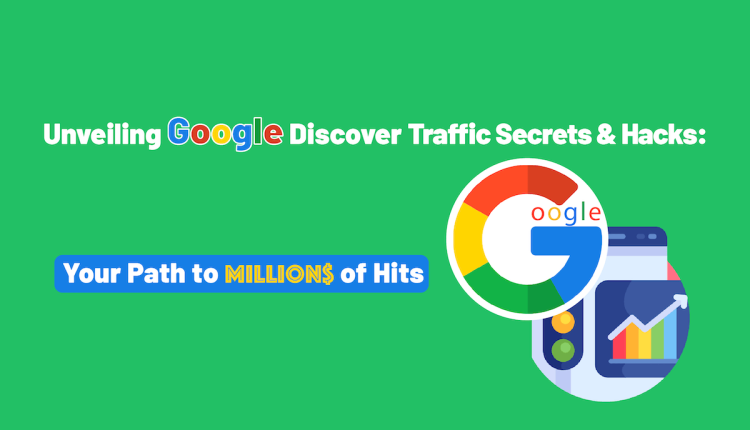In today’s digital landscape, where website traffic is the lifeblood of online success, tapping into every available avenue is crucial. Google Discover, a relatively untapped goldmine, holds the potential to flood your website with millions of hits. Welcome to the realm of “Google Discover Traffic Secrets & Hacks,” where we unveil the strategies that can transform your online presence. In this article from Twilinstok, you can discover how to navigate this dynamic platform and skyrocket your traffic like never before.
What is Google Discover Traffic?
Before diving into the strategies, let’s grasp the essence of Google Discover. Designed as a personalized content feed, Google Discover delivers articles, news, and topics directly to users based on their interests. Its algorithm curates a collection of content, making it accessible on users’ mobile device home screens. This tailored approach makes Google Discover a promising avenue for boosting website traffic, offering your content to an engaged and targeted audience.
Why Google Discover Matters?
The significance of Google Discover lies in its massive reach and engagement potential. With over 800 million active users globally and available in numerous languages, Google Discover serves as a gateway to an expansive audience. By leveraging this platform, you’re opening doors to a diverse user base that is already accustomed to engaging with content aligned with their interests. The platform’s seamless integration into users’ daily routines enhances the likelihood of your content being discovered.
How to Get More Traffic from Google Discover?
In the bustling realm of online content, capturing the attention of your target audience is a perpetual challenge. Enter Google Discover, a powerful platform that curates content tailored to individual interests, serving it directly to users on their mobile devices. This article unveils the secrets and strategies behind Google Discover Traffic, offering insights and tactics that can potentially lead to millions of hits. As we delve into this comprehensive guide, you’ll gain valuable knowledge on leveraging Google Discover to elevate your website’s visibility and engagement.
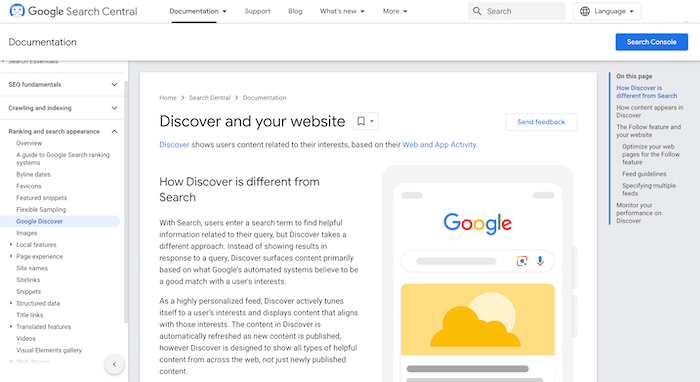
How to Optimize Your Blog Posts for Google Discover Traffic?
Optimizing your content for Google Discover involves a multifaceted approach that emphasizes content quality, visual appeal, and user engagement. Let’s delve into the specific strategies that can elevate your content to Google Discover’s spotlight. Here are 3 tips to optimize your blog posts for Google Discover traffic:
- Crafting irresistible content
- Mastering visual appeal
- Leveraging user engagement signals
Now let’s check these tips
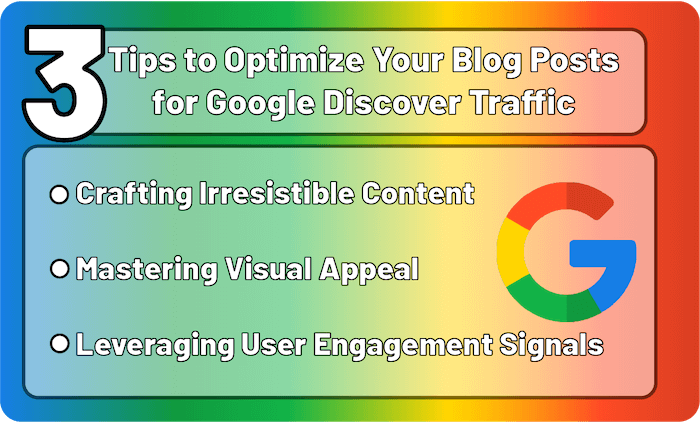
Crafting Irresistible Content
Creating content that resonates with users is the foundation of Google Discover optimization. High-quality articles that offer unique insights, solutions, or valuable information cater to users’ interests and align with Google Discover’s preferences.
Mastering Visual Appeal
Visuals play an integral role in Google Discover’s content selection. Incorporating attention-grabbing images, informative infographics, and engaging videos can make your content stand out in users’ feeds.
Leveraging User Engagement Signals
User engagement signals serve as guiding principles for Google Discover’s algorithm. Craft compelling titles and meta descriptions that spark curiosity, encouraging users to engage and explore your content fully. Emphasize user interaction to optimize engagement metrics.
Cracking the Google Discover Algorithm
Understanding the Google Discover algorithm is fundamental to optimizing your content for this platform. Here, we’ll explore key aspects of the algorithm and how they impact content visibility and engagement:
- User engagement signals
- Personalization
- Content freshness
- Content quality
- Topic relevance
- Diverse content
Now let’s check each of these aspects.
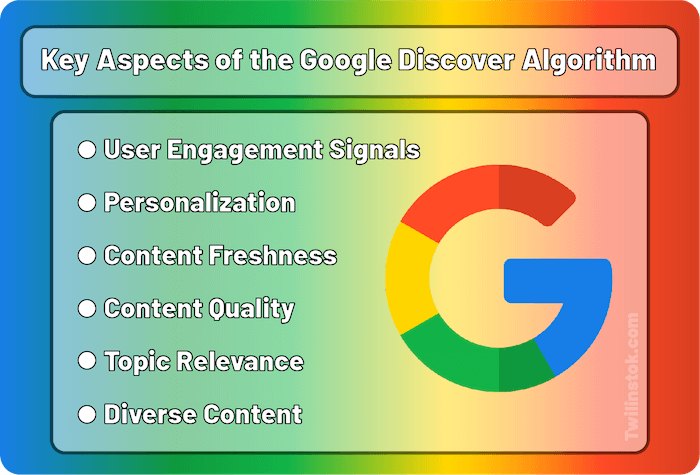
User Engagement Signals
- Signal: Google Discover closely monitors user engagement signals, such as click-through rates (CTR), dwell time, and interaction with content elements.
- Example: Suppose you publish an article titled “Top Travel Destinations in 2023.” Users who discover this article via Google Discover click on it frequently due to its enticing title and stunning visuals. They spend an average of 5 minutes reading, scrolling through image galleries, and engaging with related articles linked within. These positive user engagement signals signal to Google Discover that your content is valuable and should be promoted more prominently.
Personalization
- Signal: Personalization is a core component of the Google Discover algorithm. It tailors content recommendations to individual user preferences based on past interactions and search history.
- Example: If a user frequently searches for “Healthy Recipes” and clicks on articles related to vegetarian diets, Google Discover will prioritize showing them content related to healthy and vegetarian recipes. This personalization ensures that users receive content aligned with their interests, increasing the likelihood of engagement.
Content Freshness
- Signal: Google Discover values fresh and up-to-date content. Recent articles are more likely to be featured prominently.
- Example: Imagine you operate a tech news website, and you consistently publish articles about the latest smartphone releases. When a new flagship phone is launched, your timely article covering its features and specifications is favored by Google Discover. Users searching for information on the new phone are more likely to discover your article because of its freshness.
Content Quality
- Signal: High-quality content, including well-researched articles, informative visuals, and engaging elements, is favored by the algorithm.
- Example: Your website publishes an in-depth guide titled “Mastering Digital Photography.” This guide not only contains comprehensive information but also includes interactive tutorials, expert insights, and high-resolution images. Google Discover recognizes the quality and comprehensiveness of your content, leading to increased visibility among users interested in photography.
Topic Relevance
- Signal: Google Discover prioritizes content that is relevant to a user’s interests and search history.
- Example: A user who frequently searches for “Home Gardening Tips” will be more likely to encounter your articles on topics like “Indoor Plant Care” or “Creating a Balcony Garden.” Google Discover identifies the user’s interest in gardening and delivers content that aligns with their preferences.
Diverse Content
- Signal: Google Discover aims to provide a diverse range of content to users, encouraging exposure to various topics and perspectives.
- Example: While a user primarily engages with technology-related content, Google Discover also introduces them to articles on travel, cooking, and fitness. This diversification broadens the user’s interests and keeps them engaged with a wide range of content.
Generally: Understanding these aspects of the Google Discover algorithm empowers content creators to tailor their strategies effectively. By focusing on user engagement, personalization, content freshness, quality, topic relevance, and diversity, you can optimize your content for this dynamic platform and increase its visibility among your target audience.
Content Strategies for Google Discover
Armed with insights into the algorithm, let’s explore content strategies that align with Google Discover’s preferences and captivate your audience.
Storytelling Mastery
Mastering the art of storytelling is a potent strategy for captivating users on Google Discover. Effective storytelling not only engages users but also keeps them coming back for more. Consider the following example:
Example: Imagine you run a travel blog, and your article on “Exploring Hidden Gems in Bali” employs storytelling techniques. You weave a narrative about your personal journey through Bali, describing the lush landscapes, cultural encounters, and adventures. Your storytelling not only informs but also immerses readers in the experience, making your content highly engaging and shareable.
Engaging storytelling has the power to captivate users and retain their attention. Craft articles that tell compelling stories, addressing user needs, solving problems, and guiding them on a journey of discovery.

The Power of Visuals
Visual content is a driving force on Google Discover, as it enhances the appeal and shareability of your articles. Here’s an example of harnessing the power of visuals:
Example: If you operate a recipe website, your article on “Delicious Homemade Pizza Recipes” incorporates high-quality images and perhaps even a step-by-step video. Visuals showcase the mouthwatering pizzas in their full glory, making users more likely to click and explore the recipe. These visuals not only entice users but also aid in conveying the cooking process effectively.
Visual content enhances the appeal of your articles and supports your narrative. Infographics, images, and videos that complement your written content can significantly improve user engagement.
Interactivity and Engagement
Fostering user interaction and engagement within your content is a powerful way to increase dwell time and overall user satisfaction. Consider this example:
Example: Suppose you manage a health and fitness blog, and your article on “Effective Home Workouts” includes an interactive quiz. The quiz allows users to assess their fitness levels and receive personalized workout recommendations based on their responses. This interactive element not only keeps users engaged but also provides them with tailored content, enhancing their overall experience.
Foster user interaction by incorporating interactive elements within your content. Implement quizzes, polls, comment sections, and other engagement tools to keep users involved and prolong their time spent on your site.
Measuring Success on Google Discover
Evaluating the effectiveness of your Google Discover optimization efforts requires monitoring key metrics and understanding user behavior.
Key Metrics to Monitor
Track metrics such as click-through rates, user engagement, and the number of impressions your content receives through Google Discover. These metrics provide insights into the effectiveness of your content strategy.
Click-Through Rates (CTR): Click-through rates are a vital metric to gauge the effectiveness of your content on Google Discover. A high CTR indicates that users are not only discovering your content but are also enticed to click and explore further. For example, if your article about “Healthy Meal Planning” garners a CTR of 8%, it means that 8% of users who saw your content in their Discover feed clicked on it, showcasing its appeal.
User Engagement: User engagement encompasses various aspects, including the time users spend on your content, the number of pages they view, and their interaction with interactive elements like polls or quizzes. For instance, if users are spending an average of 5 minutes on your “Home Workout Tips” article and engaging in a fitness quiz embedded within, it reflects high engagement levels.
Impressions: Monitoring the number of impressions your content receives through Google Discover provides insights into its visibility. If your article on “Digital Marketing Trends” accumulates 100,000 impressions within a week, it signifies a broad reach, indicating that your content is being exposed to a substantial audience.
Analyzing User Behavior
Analyze user behavior patterns to identify what resonates with your audience. Examine the performance of different types of content and tailor your strategy based on these insights.
- Content Consumption Patterns: Analyzing user behavior patterns involves understanding how users interact with different types of content. For instance, if you notice that articles related to “Budget Travel Tips” consistently receive higher click-through rates and longer dwell times compared to other content, it suggests that users are particularly interested in this topic.
- Bounce Rate: Bounce rate measures the percentage of users who navigate away from your site after viewing a single page. A low bounce rate signifies that users find your content engaging and relevant. If your “Tech Product Reviews” page has a bounce rate of only 15%, it indicates that visitors are exploring multiple product reviews rather than immediately leaving the site.
- Conversion Tracking: For websites with specific conversion goals, such as e-commerce sites, tracking conversions from Google Discover traffic is crucial. If your e-commerce site experiences a 20% increase in sales of “Eco-Friendly Products” shortly after these products were featured in Google Discover, it demonstrates the positive impact of Discover traffic on conversions.
Generally: Measuring success on Google Discover requires a comprehensive approach that goes beyond mere traffic numbers. It entails assessing user behavior and engagement to determine the effectiveness of your content. By closely monitoring click-through rates, user interactions, impressions, and analyzing how users engage with your content, you gain valuable insights into the impact of Google Discover on your website’s performance. These metrics help you refine your content strategy, tailor it to user preferences, and optimize your website’s presence on this dynamic platform.

Case Studies: Success Stories
Real-world success stories offer tangible proof of Google Discover’s potential. Dive into these case studies to understand how websites have harnessed Google Discover to achieve significant increases in traffic and engagement.
The Path to Millions of Hits
Within the realm of Google Discover, numerous websites have embarked on a journey that led them to experience a remarkable surge in website traffic. These success stories exemplify the potential of Google Discover when harnessed effectively.
Imagine a website that, through strategic content optimization and user engagement, managed to secure a prominent position within Google Discover’s curated content. This website wasn’t a household name, nor did it have a colossal marketing budget. It was a testament to the fact that, with the right approach, even relatively lesser-known websites could thrive on this platform.
The journey commenced with a meticulous understanding of the Google Discover algorithm. The website’s content creators deciphered the preferences of this dynamic platform, focusing on crafting articles that aligned perfectly with users’ interests. These articles weren’t just informative; they were designed to captivate, engage, and provide genuine value to the readers.
Visual storytelling played a pivotal role in their strategy. Rich visuals, including striking images, infographics, and engaging videos, were seamlessly integrated into their content. These visual elements weren’t just ornaments; they were strategic tools that enhanced the overall user experience.
Interactivity was another key ingredient. The website incorporated features such as polls and quizzes, encouraging users to actively participate in the content. This not only prolonged the time users spent on the site but also fostered a sense of community and engagement.
User interactions, particularly click-through rates and user dwell time, steadily climbed. As a result, Google Discover began to favor their content, showcasing it prominently in users’ feeds. What was once a trickle of traffic soon turned into a steady stream, and then a flood.
The website’s analytics painted a clear picture of their success. Their articles were receiving substantial impressions, and click-through rates soared. Users were not only discovering their content but also staying engaged, consuming multiple articles in one visit.
This journey wasn’t without its challenges. Algorithm changes, content relevancy, and competition were constant factors to navigate. However, the website’s commitment to producing high-quality, user-centric content and adapting to the evolving landscape enabled them to overcome these obstacles.
The path to millions of hits on Google Discover wasn’t a one-size-fits-all journey. It was a tailored approach, rooted in an understanding of the platform, a commitment to excellence, and a passion for delivering content that resonated with users. It showcased that, regardless of the size of the website, with the right strategies and dedication, achieving millions of hits on Google Discover was indeed possible.
This case study serves as an inspiring example of how Google Discover can be a game-changer for websites of all scales, propelling them to newfound heights of online visibility and engagement.
Real-world Discover Success
Discover how businesses and content creators have harnessed the power of Google Discover to transform their online presence. These success stories offer inspiration and practical insights for your own strategy.
Overcoming Challenges
While Google Discover offers substantial opportunities for boosting website traffic and engagement, it’s essential to acknowledge and address the challenges that may arise along the way. Here, we’ll explore some common challenges and how to navigate them effectively:
- Content relevance
- User engagement
- Algorithm changes
- Competition
- User feedback
- Content diversity
Now let’s check these common challenges
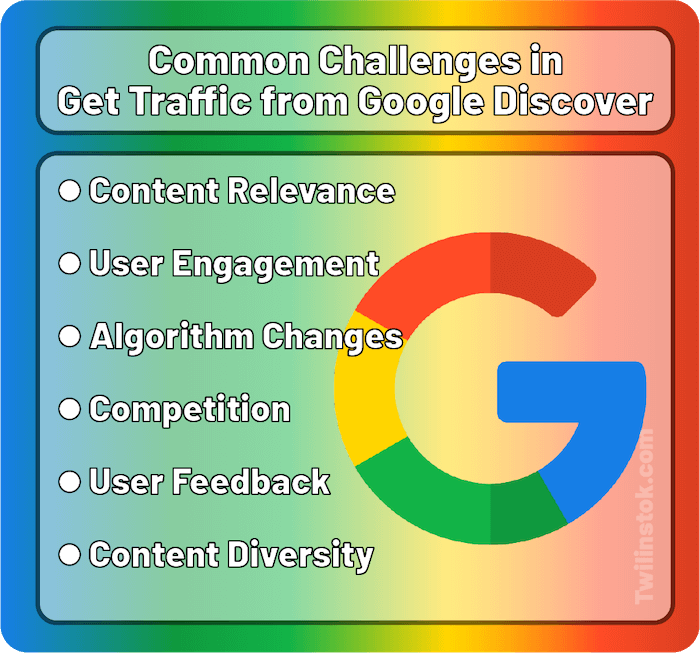
Content Relevance
- Challenge: Ensuring that your content remains relevant to your target audience and Google Discover’s evolving algorithms can be a continuous challenge.
- Solution: Stay updated with the latest trends, user interests, and algorithm changes. Regularly revisit and update your existing content to keep it fresh and aligned with current topics.
User Engagement
- Challenge: Maintaining high levels of user engagement over time can be demanding, especially as user preferences change.
- Solution: Experiment with different content formats, such as interactive quizzes, videos, and infographics, to sustain user interest. Regularly analyze user behavior data to identify what resonates with your audience.
Algorithm Changes
- Challenge: Google Discover’s algorithm is dynamic and subject to regular updates, which can impact your content’s visibility.
- Solution: Stay informed about algorithm changes through industry news and Google’s official updates. Adapt your content strategy as needed to align with algorithmic shifts.
Competition
- Challenge: As more websites recognize the potential of Google Discover, competition for visibility within users’ feeds can intensify.
- Solution: Differentiate your content by focusing on niche topics or creating exceptionally high-quality, engaging content. Additionally, consider promoting your content through other channels to boost its initial visibility.
User Feedback
- Challenge: Negative user feedback, such as low click-through rates or high bounce rates, can hinder your content’s performance on Google Discover.
- Solution: Take user feedback seriously and use it as an opportunity to improve. Experiment with different approaches, headlines, and content formats to address user concerns and preferences.
Content Diversity
- Challenge: Google Discover aims to offer a diverse range of content to users, which can make it challenging to stand out in certain niches.
- Solution: Focus on crafting unique and valuable content that addresses specific user needs or interests within your niche. Emphasize your expertise and authority in your chosen subject matter.
Conclusion
As the digital landscape continues to evolve, embracing platforms like Google Discover is essential for expanding your online reach. This article has unveiled the secrets and hacks of Google Discover Traffic, providing you with actionable strategies to unlock the potential of this dynamic platform. By embracing personalization, engaging your audience, and optimizing your content, you’re poised to witness your website traffic soar to unprecedented heights.
For more information about Search Engine Optimization, we suggest that you click on Free SEO Tutorial [+]. Also, if you have any questions about SEO, you can ask them in our SEO support center [+] in the form of a topic and wait for the answer of our experts.
FAQs
How can I optimize my content for Google Discover?
Optimizing for Google Discover involves crafting high-quality, visually appealing, and engaging content. It’s essential to focus on user engagement signals and create content aligned with users’ interests.
Is Google Discover available in multiple languages?
Yes, Google Discover is available in over 60 languages, making it a global platform with a diverse user base.
What are user engagement signals, and why are they important for Google Discover?
User engagement signals, such as click-through rates and user dwell time, indicate how users interact with your content. These signals play a crucial role in Google Discover’s content selection.
Can Google Discover benefit my business?
Absolutely. Google Discover can significantly benefit businesses by driving traffic, increasing brand visibility, and reaching a broad and engaged audience.
Are there any tools to help measure the performance of my content on Google Discover?
Yes, tools like Google Analytics and Google Search Console provide insights into your content’s performance on Google Discover, helping you track key metrics and user behavior.

